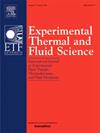Micro-PIV experimental measurements of vortex evolution inside generated droplets in T-inlet microchannel
IF 2.8
2区 工程技术
Q2 ENGINEERING, MECHANICAL
Experimental Thermal and Fluid Science
Pub Date : 2025-01-23
DOI:10.1016/j.expthermflusci.2025.111418
引用次数: 0
Abstract
The evolution of swirling intensity within droplets during the formation of squeezing microdroplets in T-inlet microchannel devices was experimentally investigated utilizing the microparticle image velocimetry (micro-PIV) technique. Swirling intensity is quantitatively characterized by defining the average rotational angular velocity of fluid units under shear-free conditions. The effects of the continuous phase capillary number and the dispersed phase flow velocity on the evolution of swirling intensity within the droplets were investigated experimentally. Experimental results indicate that the internal vortex evolution process of droplets during the formation of squeezing microdroplets can be categorized into four distinct phases. An increase in the capillary number of the continuous phase effectively shortens the microdroplet formation period while enhancing the recirculation swirling intensity within the droplets. Conversely, by adjusting the flow velocity of the dispersed phase fluid, variations in the droplet formation period can be achieved without altering the swirling intensity. These findings provide a theoretical foundation for improving mixing, mass and heat transfer processes within microdroplets.

t型进口微通道内生成液滴内涡演化的微piv实验测量
利用微粒子图像测速(micro-PIV)技术研究了t型进口微通道中挤压微液滴形成过程中液滴内旋流强度的变化规律。通过定义流体单元在无剪切条件下的平均旋转角速度来定量表征旋流强度。实验研究了连续相毛细管数和分散相流动速度对液滴内旋流强度演化的影响。实验结果表明,在挤压微液滴形成过程中,液滴内部涡演化过程可分为四个不同的阶段。连续相毛细管数的增加有效缩短了微液滴的形成周期,同时增强了微液滴内的再循环旋流强度。相反,通过调节分散相流体的流速,可以在不改变旋流强度的情况下实现液滴形成周期的变化。这些发现为改善微液滴内的混合、传质和传热过程提供了理论基础。
本文章由计算机程序翻译,如有差异,请以英文原文为准。
求助全文
约1分钟内获得全文
求助全文
来源期刊

Experimental Thermal and Fluid Science
工程技术-工程:机械
CiteScore
6.70
自引率
3.10%
发文量
159
审稿时长
34 days
期刊介绍:
Experimental Thermal and Fluid Science provides a forum for research emphasizing experimental work that enhances fundamental understanding of heat transfer, thermodynamics, and fluid mechanics. In addition to the principal areas of research, the journal covers research results in related fields, including combined heat and mass transfer, flows with phase transition, micro- and nano-scale systems, multiphase flow, combustion, radiative transfer, porous media, cryogenics, turbulence, and novel experimental techniques.
 求助内容:
求助内容: 应助结果提醒方式:
应助结果提醒方式:


